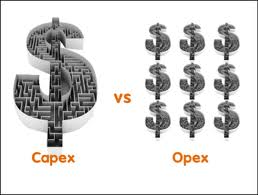CAPEX v. OPEX in Savings Calculations
This week's Wiki-Wednesday topic is CAPEX (Capital Expenditures) v. OPEX (Operating Expenditures). Once you understand the difference between them, the next step is realizing the impact that distinction has on negotiated savings recognition.
 Straight savings is usually calculated per unit as 'old price' minus 'new price'. If you have in fact negotiated savings, the number will be positive and represents the amount of savings per unit that you have negotiated. The same formula works to capture cost increases, expect the number will be positive rather than negative. Even if the cost increase has been mitigated by your sourcing process, increases make me sad, so let's stick with savings for the rest of this example.
Straight savings is usually calculated per unit as 'old price' minus 'new price'. If you have in fact negotiated savings, the number will be positive and represents the amount of savings per unit that you have negotiated. The same formula works to capture cost increases, expect the number will be positive rather than negative. Even if the cost increase has been mitigated by your sourcing process, increases make me sad, so let's stick with savings for the rest of this example.
You get projected extended savings by multiplying that number times the volume to be purchased. If you are looking to accurately reflect savings year over year you will also want to take into account changes in (or projected changes in) the volume you buy. If your company plans to buy 10% more/less of the good or service, reflect that in your savings figure.
It is also common to use a percentage which would be calculated as 'old price' minus 'new price'/'old price'. Keep in mind that all savings figures should be clearly marked as PROJECTED savings unless you are tracking the difference in price against actual invoices. Strike a balance between realism and optimism when you pick your estimate - and be conservative if you think it will hold more credibility with your company's leadership.
Another solid recommendation is to meet with someone in your company's finance department before you announce the results to the company. They will make you defend your figures, which can be frustrating, but gives your numbers greater validity.
If you have taken my advice above and spoken to someone in finance/accounting about the savings, they will want the savings to follow the same accounting rules as the good or service being purchased. Here is where the distinction between CAPEX and OPEX comes into play. There are exceptions to everything, but as a general rule, operating expenses are for goods that will be purchased and consumed within a year. Hired services are always operating expenses for that reason. Capital expenditures are larger purchases that will last longer than a year. If you are calculating savings for a capital purchase, you would typically recognize the savings over the same schedule used to depreciate the purchase. For example, if you save $1M on a large construction project, you can't realize that entire savings in the first year. I believe 30 years is the term often used for depreciating real estate and the associated savings. That's kind of a bummer if you are a construction category manager. 30 years is a long time. Chances are you won't work at the company long enough to see all of those savings come in.
I made my bones in grocery retail, so here are some other examples of the difference between CAPEX and OPEX sourcing projects:
Meat slicer: CAPEX. Gloves worn while using the slicer: OPEX.
Cash register: CAPEX. Register receipt tape: OPEX.
Elevator: CAPEX. Elevator maintenance services: OPEX. (And this example is trickier than the others, because often both are provided by the same supplier.
When you subscribe to the blog, we will send you an e-mail when there are new updates on the site so you wouldn't miss them.